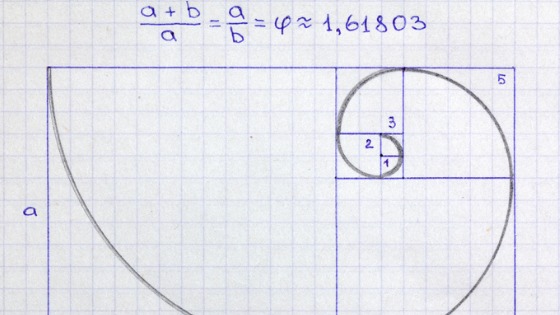Certain numeric values are named because they have unusual properties. The golden ratio and Fibonacci sequence are two such numbers. Pi is another value known more by its name than its value. Pi is the ratio of the circumference of a circle to its diameter. No matter the size of the circle, the ratio will always be pi or 3.14159. We have known about pi since Archimedes first calculated it (287-212 BCE).
The Fibonacci sequence of DaVinci Code fame is a sequence of numbers where each number is the sum of the previous two numbers. The sequence begins 1, 1, 2, 3, 5, 8 . . . to infinity. The numeric sequence appears in a book published by Leonardo Fibonacci in the 12th century, although civilizations were aware of its existence before then. Further, the Fibonacci sequence has a special relationship with the golden ratio. The ratio of a term in its sequence to the one before it approaches the golden ratio.
What Is the Golden Ratio?
Like pi, the Golden Ratio has existed since the beginning of time. It appears in ancient writings under different names such as golden mean, golden section, and the divine ratio. The first recorded use of the golden ratio or phi occurred in the 5th century BCE in Greece. Phidias used the ratio to design the Parthenon sculptures. Plato saw the golden section as binding mathematical and physical relationships. In the 4th century BCE, Euclid discovered what he called the golden mean of 1.618, which he linked to the construction of a pentagram.
In 1509, Luca Pacioli’s dissertation presented the idea that 1.618 formed the basis for the Divine Proportion or Ratio. It was used extensively during the Renaissance to achieve balance and beauty in art. Leonardo Da Vinci’s The Last Supper is often cited as an example of the golden ratio’s application in art. Da Vinci used the ratio to establish the table dimensions and the relative positioning of the disciples to make the painting more proportional and visually appealing.
However, the term golden was not applied to the ratio until 1815 when Martin Ohm used it in his book The Pure Elementary Mathematics. In the 20th century, the ratio was assigned the Greek letter phi. Phi is the first letter of Phidias’ name and is the equivalent of the letter F, which is the first letter of Fibonacci’s name.
How Does the Golden Ratio Work?
The divine ratio is used in the design. Whether it is the design of a web page or a painting masterpiece, ensuring the proportions approximate the golden ratio means the result will be visually appealing. Apply this perfect ratio to parts of a design, as well as the design itself. For example, take the height of a page and divide it by 1.618. The result is the most proportional width for the page. Repeating the process for subsets of design, such as column sizes, helps maintain a page that is attractive to the human eye.
When researchers applied the golden ratio to the human face, they found that the closer the facial relationships were to 1.618, the more people consider the face beautiful. Here are a few examples:
- Ratio from the center of the pupil to the bottom of the teeth to the ratio from the bottom of the teeth to the bottom of the chin.
- Ratio of the width of the eye to the width of the iris for both eyes.
- Lastly, the ratio of the outer edge of the eye to the center of the nose with the inner edge of the eye to the center of the nose.
The information helps artists and designers as they create human likenesses. It also helps make characters in films more or less attractive.
Where Is It in Daily Life?
What makes the golden ratio so fascinating is the number of places it appears. For example, the Fibonacci spiral is a logarithmic spiral that grows by the value of the golden ratio for every quarter turn in the spiral. The most cited examples are snail and nautilus shells. However, the spiral also describes the Milky Way and the rotation of hurricanes.
Plants are a frequent example of the divine ratio. The petals on flowering plants are a Fibonacci number. This arrangement of petals follows the golden ratio to maximize its exposure to sunlight.
Why Is It Important?

In the financial markets, the golden ratio predicts movement trends. Its properties help describe the world around us from the cosmos to our DNA. It is found so frequently in nature that some consider it a “universal law”. The ratio describes how tree branches form and how our circulatory system works. Mystics since the Egyptians have viewed it as a sacred number that could lead to enlightenment.
Architects use the ratio in building design. Many architects have proportioned their designs to approximate the golden ratio. Some of the great buildings were built using the golden ratio. For example,
- Parthenon
- Sydney Opera House
- National Gallery in London
Without this ratio, it would be difficult for us to understand our universe.
How to Calculate a Golden Ratio?
The formula for calculating phi is:
(A+B)/A = A/B, where
A is the longer segment
B is the shorter segment
If the proportions entered are a golden ratio, the values will approximately 1.618. Or, you can let a golden ratio calculator do the work.
The golden ratio is a fascinating bit of mathematical lore. It is also an excellent tool for creating eye-catching web pages. Why not check out the web development programs powered by Woz U?




